Summer’s here and it is time for fun loving cyclists to gear up and go cycling from Manali to Leh. We have put together a comprehensive and exhaustive guide to help you plan and prepare for your dream ride.
An Attitude for Altitude: Cycling from Manali to Leh!
For centuries, humans have had an unyielding fascination with reaching the top. Every mountain peak must be conquered, every ceiling breached. For most cyclists in India, cycling from Manali to Leh is a journey beyond the ordinary. The sheer altitude attracts riders from different countries of the world.
In recent years, one of the highest bicycle races in the world, La La Land Ultra, was held in this frozen desert. Life at this altitude requires a different attitude than that of the plains below. An overconfident approach might lead to a setback in the high mountains, which can be lethal. These lofty mountains teach us humility and the magnanimity of nature.
Preparation for this arduous route should begin at least 6 months in advance. It’s not just the spirit that should be willing to undertake this journey, but the body as well. Regular bicycle rides and training are crucial to ensure that you are well equipped to take on the daunting task at hand. You will end up changing your entire lifestyle, from eating healthy to sleeping properly and being a part of Fit India!
The route from Manali to Leh is roughly 475 km. At first glance, it might not seem like a daunting task, but for cyclists, distance is not the best parameter. Instead, we need to look at the massive elevation to be gained.
Starting from Manali, we first climb Rohtang La at 3980 metres above Mean Sea Level, from a paltry 2000 metres of Manali. After descending to Tandi, we once again climb to 4890 metres of Baralacha La before descending to Sarchu. The climb continues to Nakee La and Lachung La at 4740 metres and 5079 metres, respectively. The final big pass before Leh is Tanglang La at 5328 metres. When you reach Leh, it is still not over, as you are left to climb the jewel in the crown, Khardung La. K-Top, as it is known among enthusiasts, sits proudly at 5359 metres, and is one of the highest motorable roads in the world, as the Border Roads Organisation signpost proudly states.
The route itself offers excellent vistas. From the greenery-covered Himachal, where there is a tree in any direction you look, to the entire section post Darcha, where the world is brown in every direction you look. Except if it is covered with snow, then it is white in every direction.
The people of the region are supremely helpful and have gentle demeanours. They are soft-spoken and humble in these harsh terrains. The majority of this route is uninhabited, except in the summer months, where camps spring up to cater to travellers. Ladakh is predominantly Buddhist, and there are plenty of monasteries to visit in the region around Leh. The calming influence of these sacred places is soothing for us urban dwellers.
For the adventurer, the road varies drastically. From billiard table smooth asphalt to non-existent roads to tumultuous water crossings, every turn throws up another challenge. The flat for miles, More Plains is a sight worth beholding, as it sits in the bowl of high mountains. The ruggedness of Baralacha La and the campsite of Bharatpur can make or break the spirit of a rider. You are tested with every pedal stroke of the way and rewarded with views that will stay with you for the rest of your life.
There is a reason why Ladakh is popular the world over. Nothing else on earth can match it!
Preparation is Key for happily Cycling Manali to Leh
Below are the elements you need to prepare for a fun filled adventure.
Reaching Manali
Getting to Manali with your bicycle is the first challenge you will face. Before the first pedal stroke.
The most convenient (and economical) way to get to Manali is fly to Delhi (if you live south of Madhya Pradesh). From there take a Himachal Pradesh Tourism Development Corporation Volvo bus to Manali. You can book the bus ticket online. The buses are comfortable, clean and the storage space easily will accommodate your bicycle. You would need to pay a ‘half-ticket’ for your bicycle as excess luggage.
You can also reach Chandigarh and take a bus to Manali from there. The journey from both cities are overnight. So you reach early morning in Manali.
The most adventurous, start riding as soon as they get off the bus. But we suggest staying the day (or two) in Manali, getting a good night’s sleep and starting the next morning fresh.

Best Time to Go
The best time to go cycling from Manali to Leh is from mid-June to mid-September. During this period, the roads are open and free of snow, and the weather is generally dry and sunny. This makes for ideal cycling conditions, as the roads are not slippery and visibility is good.
However, it’s important to note that even during the summer months, the weather in the region can be unpredictable and change rapidly. Cyclists should always be prepared for sudden drops in temperature, strong winds, and rain.
Additionally, it’s important to acclimatize to the altitude before beginning the journey, as the high altitude is the biggest challenge.
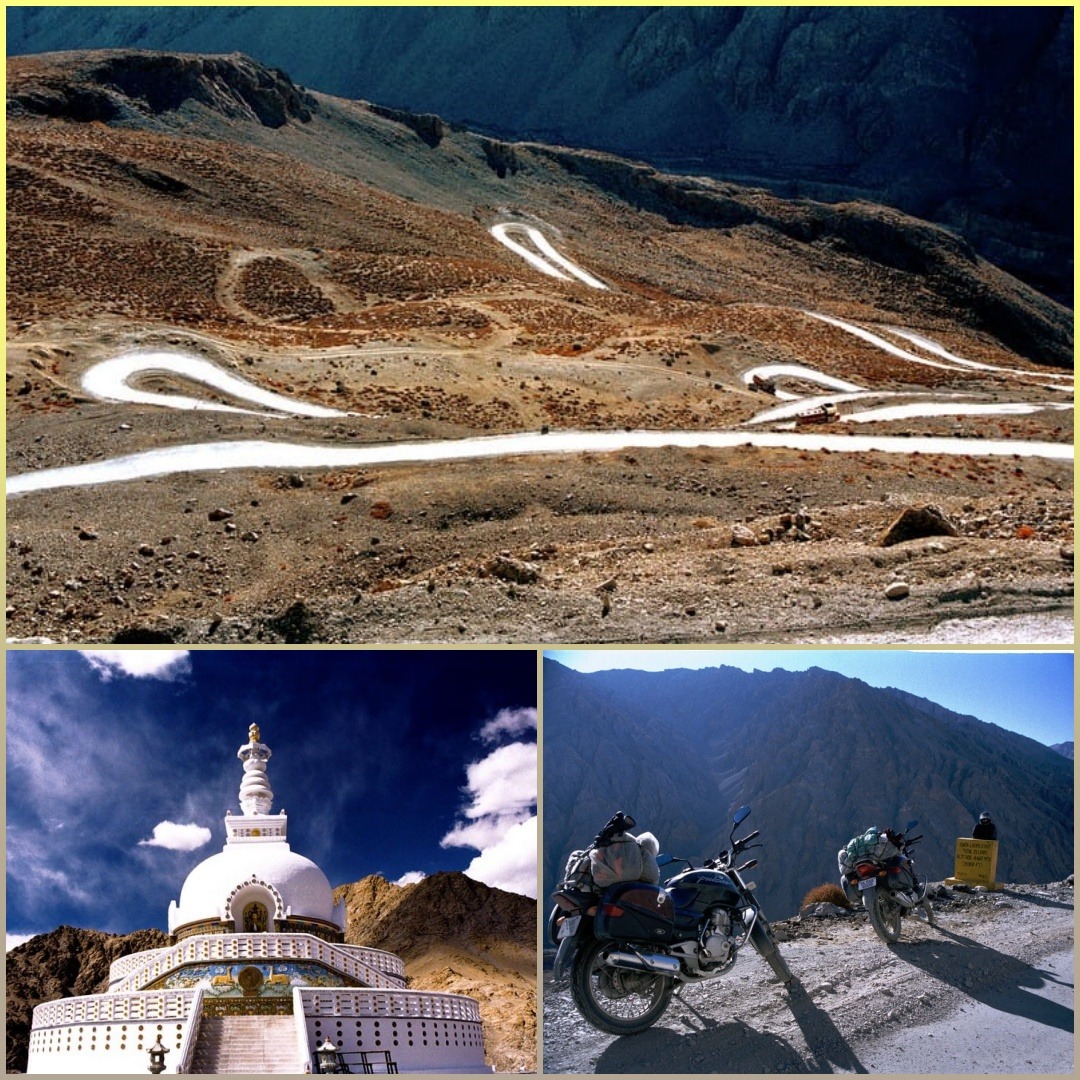
Necessary Gear and Equipment and type of cycle
The first question is: What bike?
- The first option is to use a dedicated steel framed tourer.
- The second option is a road bike, which is capable of handling bad roads. If a person is comfortable with road bikes and has used it on various ‘bad’ roads of India then it can easily be taken up there.
- The last and least desirable option is to take a Mountain Bike (MTB). The problem is cyclists don’t quite know English, so they call a bike meant for trails and off-roading an MTB! In Ladakh you will always be on the ‘road’, so an MTB is not required. Yet most favour an MTB.
- A hybrid bicycle or gravel bike works great on this route.
Preparing your bike
- Tyres: Use around 30-35 mm tyres, depending on how much luggage you are looking to carry.
- Forks: Ditch those heavy suspension forks and put stiff ordinary forks, preferably with eyelets for a front rack, if you are planning to carry a lot of luggage. If one insists on using front suspension, then make sure it has a suspension lockout. As 95% of the time you would want to be riding with the suspension locked.
- Handlebars: This depends entirely on what the rider is comfortable with. Use whatever you have clocked the maximum number of miles on. DO NOT switch to something new before the ride. If you are using the stock MTB bars, then it is a good idea to use bar-ends. It is nice to have multiple hand positions when climbing for long hours.
- Saddle: The most important. Invest in a good quality saddle. Make sure it properly fits your posterior! It is the difference between being a happy bum or not. And clock a lot of miles on it, before using it on this tour.
- Pedals: Clipless pedals can be quite annoying especially, when one has to get off and cross deep streams on foot. One can always use touring shoes and pedals which is easier to walk in. Flat pedals offer the best trade-off for touring.
- Racks: A strong, yet not too heavy front (if there is lots of luggage) and rear rack. Medium sized backpacks can be bungeed onto the rack or dedicated panniers can be used. A handlebar bag and saddle bag is useful for putting in knick knacks which need to be at hand throughout the day. The alternative is to use a bikepacking setup, if you want to go lightweight.
- Brakes: Make sure you are running good quality brakes. Even if one is riding a cheap cycle, the brake set should be upgraded as a priority. Also change brake pads if required and carry the old ones as spares.
- Bell and mirrors: The former not so much, while the latter is useful, because there is now a lot of vehicular traffic on this route.
- Kick stand: Useful, especially when touring solo and photography is important, but otherwise not mandatory.
- Mudguards: At least a front mudguard, as the front tire tends to throw up slush in the rider’s face.
- Headlight and tail light: Necessary, even basic entry level stuff will do. You will not want to be riding after dark, carry it as insurance.
- Helmet: No helmet, no ride!
Physical fitness and Training
Get up, stop reading this article and start riding! Now that you have done a ride and are back, read on!
You are going to be riding on some of the highest roads in the world. There is a lot of climbing involved and you will have luggage to weigh you down. You can never be ‘too’ fit!
The fitter you are, the faster you will be; but the suffering up the climbs won’t reduce. Fortunately that is good news for those who have low to moderate levels of cycling fitness. If you aren’t too fit, remember you will only be going a bit slower, that’s it!
Riding 40-50 km 3-4 times a week in the 3 months before the trip means you will ‘complete’ the Manali-Leh route. If you are riding for longer than that, all the better, you will enjoy the ride more!
If you are fortunate enough to live somewhere close to the hills then practice riding on the climbs as often as you can. Try to do a few 100 km rides on weekends if you are unlucky and live in the plains.
The important thing is to have your basics right. Having the correct bike size, bike fit and pedalling optimisation is necessary. Spending long hours in the saddle with any of these incorrect will cause injury by repetition. Medical aid is not something you want to count on in these far away mountains.
Google is your friend, read up on how to pedal properly, sitting posture, bike fit, training and nutrition techniques etc.
Recommended Route from Manali to Leh by cycle
The route from Manali to Leh is a challenging and scenic journey through the Indian Himalayas. The total distance of approximately 475 km takes you through some of the highest motorable passes in the world. Starting from Manali, you climb the first pass, Rohtang La, at an altitude of 3980 meters, before descending to Tandi. You then climb to Baralacha La at an altitude of 4890 meters before descending to Sarchu. The route continues with more challenging passes such as Nakee La, Lachung La, and Tanglang La, before reaching Leh.
The journey is not only challenging but also offers breath-taking views of the Himalayan landscapes. You will see the greenery-covered hills of Himachal Pradesh and the barren mountains of Ladakh. The More Plains, a flat stretch of land surrounded by high mountains, is a particularly stunning sight. The people of the region are friendly and hospitable, and the Buddhist monasteries provide a calming influence.
Links to Route GPX files: Manali to Zing Zing Bar, Zing Zing Bar to Pang, Pang to Leh.

Potential Overnight Stops and Accommodation
When cycling from Manali to Leh, there are several overnight stops and accommodation options available for cyclists. Here are some of the popular ones:
- Marhi – This is the first overnight stop after starting from Manali. It is located at a distance of around 35 km and offers basic accommodation options like guesthouses and tents.
- Keylong – This is a town located at a distance of around 115 km from Manali. It offers a variety of accommodation options like hotels, guesthouses, and homestays.
- Jispa – This is a scenic village located at a distance of around 135 km from Manali. It offers accommodation options like campsites, guesthouses, and hotels.
- Sarchu – This is a high altitude stopover located at a distance of around 215 km from Manali. It offers a few tented accommodations and campsites for cyclists.
- Pang – This is a remote village located at a distance of around 300 km from Manali. It offers basic tented accommodations and campsites.
- Upshi – This is a small village located at a distance of around 445 km from Manali. It offers basic guesthouses and homestays.
- Leh – This is the final destination of the Manali-Leh cycling route. It offers a wide range of accommodation options like hotels, guesthouses, and homestays.
Some cyclists opt to carry their own tents and camping equipment for greater flexibility and independence. But there is no reason you need to do this. It only adds weight to your luggage.
Safety is Priority
Cycling from Manali to Leh is a challenging and thrilling experience that requires adequate preparation and precautions to ensure a safe and enjoyable journey.
Altitude Sickness
One of the biggest safety concerns for cyclists is the risk of altitude sickness. As the route passes through some of the highest mountain passes in the world, cyclists are likely to experience symptoms such as headache, nausea, dizziness, and fatigue due to the high altitude.
To prevent altitude sickness, it is recommended to gradually acclimatize to the high altitude by spending time in Manali before starting the journey and taking breaks along the route to allow the body to adjust to the altitude.
Weather Conditions
Weather conditions are another potential safety concern for cyclists on this route. The weather in the region can be unpredictable and harsh, with sudden rain or snowstorms, strong winds, and extreme cold temperatures.
It is crucial to check the weather forecast before starting the journey and to carry appropriate gear and clothing, such as waterproof and windproof jackets, warm layers, and gloves. It is also advisable to carry a first-aid kit and essential medicines for emergencies.
Road Conditions
Another important safety concern is the condition of the roads, which can be rough and unpredictable. Be cautious while riding and avoid taking unnecessary risks.

Tips for Managing Risks
Here are some tips for avoiding and managing risks like weather and altitude while cycling from Manali to Leh:
- Acclimatize properly: Spend time in Manali to allow your body to adjust to the high altitude. Drink plenty of water and avoid alcohol, caffeine, and sleeping pills.
- Dress appropriately: Pack for a variety of weather conditions, including warm clothing, rain gear, and a good quality windproof jacket. Dress in layers so you can adjust to changing temperatures.
- Stay hydrated: Drink plenty of water, even if you don’t feel thirsty. Dehydration can make altitude sickness worse.
- Watch for symptoms of altitude sickness: These can include headache, nausea, dizziness, and shortness of breath. If you experience any of these symptoms, descend to a lower altitude immediately.
- Use sunscreen and wear a hat: The high altitude and thin air can lead to sunburn and skin damage, even on overcast days.
- Check weather conditions: Monitor weather forecasts before and during your trip. Avoid cycling during rain or snowfall. Strong winds can also make cycling more challenging and risky.
- Plan your itinerary: Be aware of any road closures or construction.
- Carry a first aid kit: Pack a basic first aid kit including medicines for altitude sickness, pain relievers, and bandages. In case of emergency, there might be no medical help available immediately.
- Be visible: Wear bright or reflective clothing to increase your visibility to other vehicles. Use lights and reflectors on your bike to make sure you’re visible in low-light conditions.

Local Culture and Customs
Cycling from Manali to Leh offers a unique opportunity to experience the diverse cultural heritage of the region. Some of the notable cultural experiences that cyclists encounter along the way include:
- Monasteries: The region is home to numerous monasteries that offer a glimpse into the traditional way of life in the Himalayas. Cyclists can visit monasteries such as the Hemis Monastery, Thiksey Monastery, and Diskit Monastery.
- Local Markets: Cyclists can stop at local markets, such as the ones in Manali, Keylong and Leh, to explore traditional crafts, clothing, and food.
- Festivals: The region is known for its vibrant festivals, such as the Hemis Festival, which celebrates the birth anniversary of Guru Padmasambhava. Cyclists may have the chance to witness or even participate in these festivals.
- Local Cuisine: The region boasts a unique cuisine that blends Tibetan, Indian, and Central Asian flavours. Cyclists can sample local delicacies such as momos, thukpa, and chhang.
Navigation
Navigation on this route is ridiculously easy. There’s just one road. You have to be a magician to get lost!
But getting lost is not the worry for cyclists. It is knowing the layout of the land which can make life easier. Since there is no phone and internet connectivity along most of the route. You have to learn to live life offline.
The biggest friend and saviour of cyclists in such situation is Maps.Me. It is a free offline maps app available for Android and iOS phones. Download the maps in advance and upload the KML file onto the map. That way you can check every day the elevation profile of the segment you will be tackling. Knowing, is having won half the battle!
In the cold, batteries get drained quickly. So your phone or bicycle computer might be unusable. It is therefore prudent to carry a hardcopy of the elevation profile of the route.

Conclusion
We would love to say that after cycling from Manali to Leh, you will be elated. But that elation will only last a few months. Riding this route will not let you retire from your bicycle and go home to regale your future grandchildren with tales.
Instead, this route is only the seed. Once planted in your mind, it will grow constantly. Calling you back to the mountains. Calling you to explore some more of Ladakh, the Himalayas and the world…
Photos: Daksh Jadhav, Gaurav Negi, Hitisha Mehta, Jagadish Kulal, Madhav Dubey, Sandeep Goswami, Pachu Shetty, Rayan Serrao, Shashank Rohilla, Siddhanth Singh. (Follow Them on Their Instagram Accounts)
Also read, bikepacking vs pannier touring? and a Guide to Cycling Through Spiti!



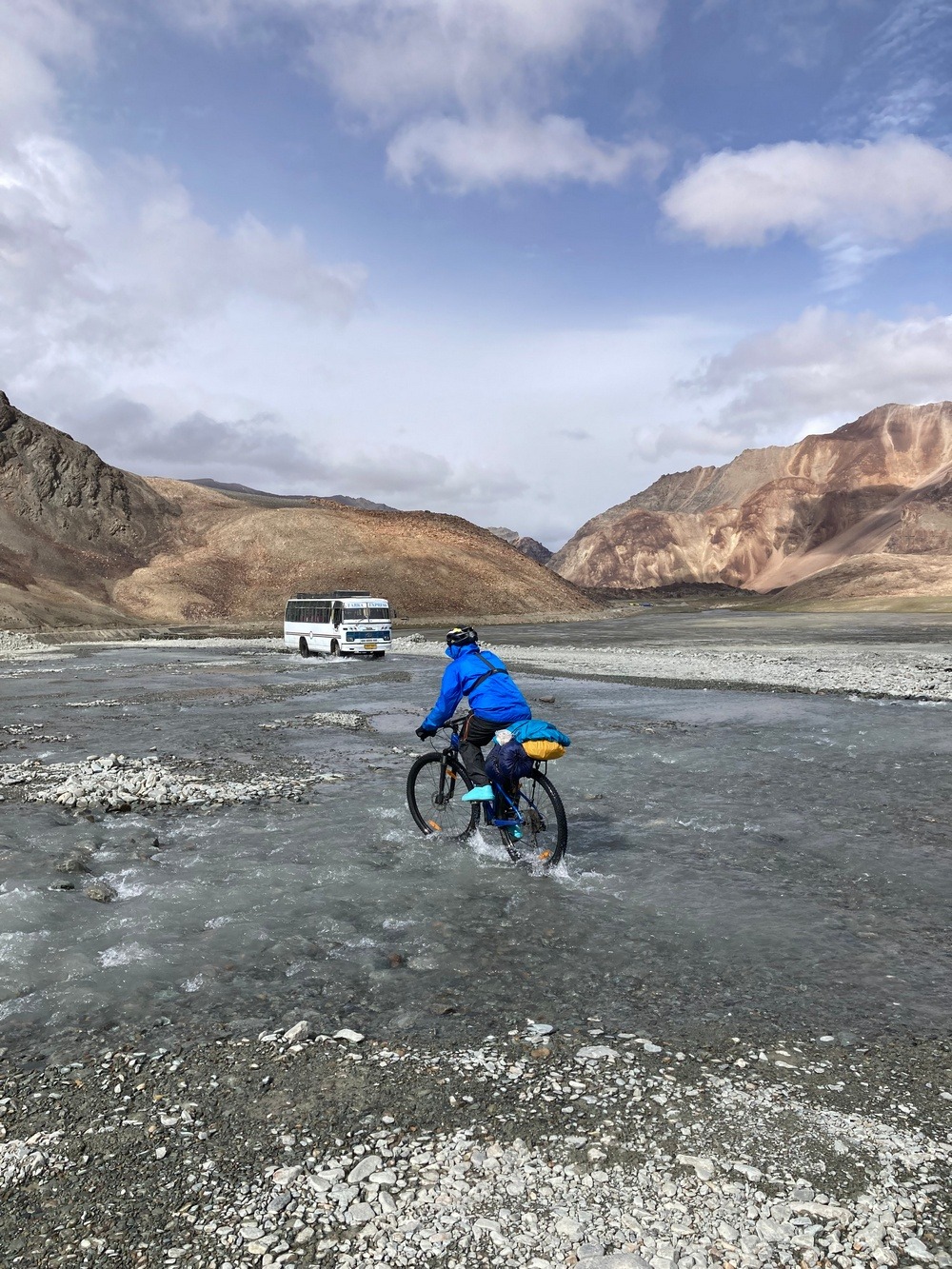
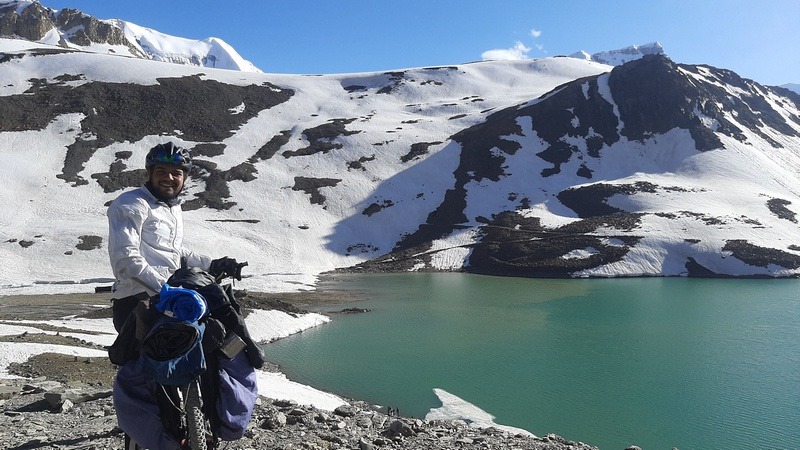
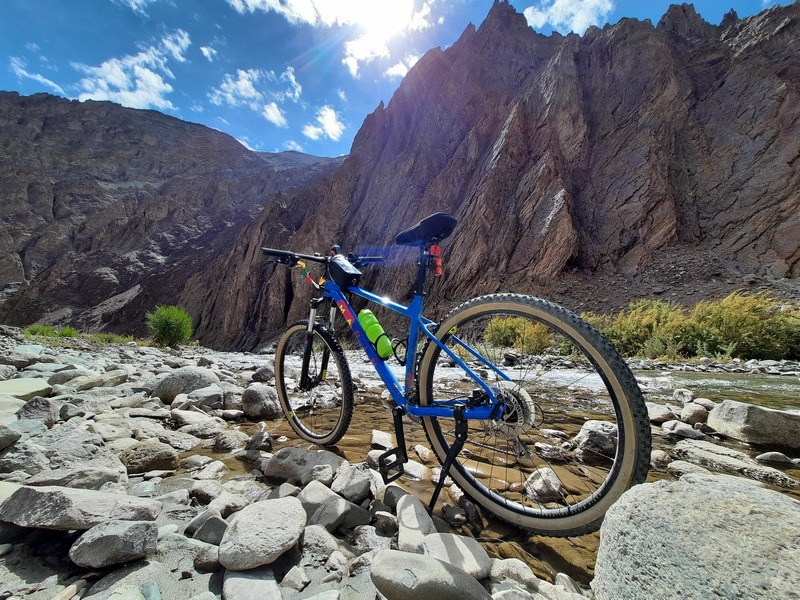
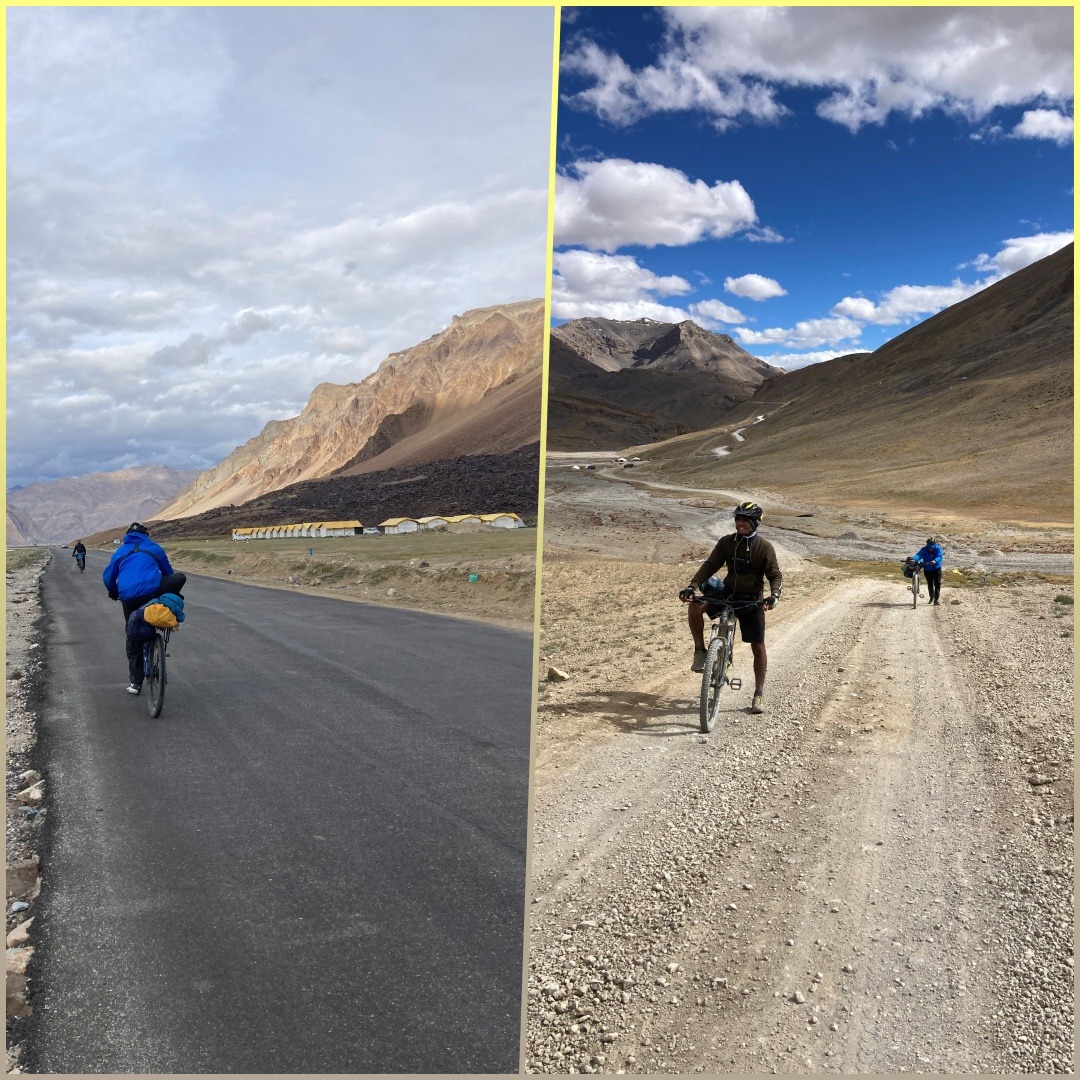




Very cool article. Nicely collated.
Well structured and informative
best bicycle to purchase if i’m going delhi to leh
if i go for a tourist bike then i can’t use that on daily basis
If you want to buy a bike which will be good for your tour from Delhi to Leh and then again to be ridden around in the city later, then we suggest either going for a hybrid or gravel bike, depending on your budget.
You can check out the hybrid bicycle guide: http://cyclingmonks.com/best-hybrid-cycle-under-30000/
And the gravel bike guide: http://cyclingmonks.com/gravel-biking-india/
All the best and safe travels!